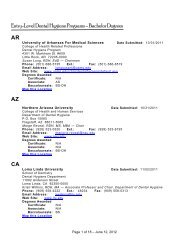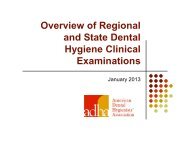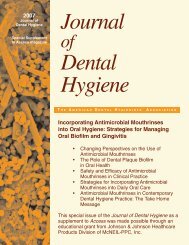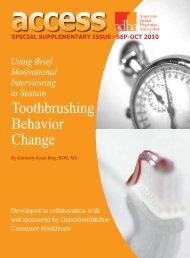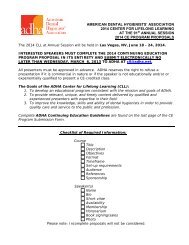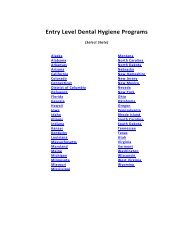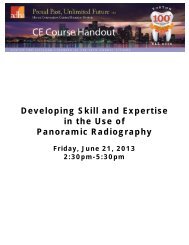Relationship Between Oral Health and Systemic Disease - American ...
Relationship Between Oral Health and Systemic Disease - American ...
Relationship Between Oral Health and Systemic Disease - American ...
Create successful ePaper yourself
Turn your PDF publications into a flip-book with our unique Google optimized e-Paper software.
INFLAMMATION:The <strong>Relationship</strong> <strong>Between</strong><strong>Oral</strong> <strong>Health</strong> <strong>and</strong><strong>Systemic</strong> <strong>Disease</strong>By JoAnn R. Gurenlian, RDH, PhDspecial supplement toaccess april 2006sponsored by
Patients, dental hygienists, dentists,dental specialists <strong>and</strong> other healthcare providers should be aware ofthe consistent relationships betweenoral inflammation <strong>and</strong> systemicdiseases. They should value the needto modify assessment, prevention, <strong>and</strong>treatment protocols to improve the oralhealth as well as total health of thepatients they treat in the officeeach day.
contentsAbstract . . . . . . . . . . . . . 1The InflammatoryProcess . . . . . . . . . . . . . . 1Inflammation &<strong>Oral</strong> <strong>Health</strong>. . . . . . . . . . . 2The <strong>Oral</strong>-<strong>Systemic</strong><strong>Relationship</strong> . . . . . . . . . . 3Translating Scienceto Practice . . . . . . . . . . . 5Conclusion. . . . . . . . . . . 6A Case in Point . . . . . . . 7AbstractSince the mid 1990s, both the scientific community <strong>and</strong> thepublic have been inundated with articles addressing the associationbetween systemic diseases <strong>and</strong> oral health. It seems that almostmonthly there is an article in a fashion magazine reminding thepublic that tooth brushing <strong>and</strong> flossing can save their life. Somearticles point to the notion thatoral infection <strong>and</strong> bacteria maybe linked to heart attack <strong>and</strong>stroke. Others dispel the association,indicating that there is notenough research to determineany relationship between thetwo. The questions that havebeen raised focusing on the relationshipbetween periodontaldiseases <strong>and</strong> systemic conditionsnow extend beyond cardiovasculardisease <strong>and</strong> include diabetes,respiratory disease <strong>and</strong> adversepregnancy outcomes. ResearchResearch hasdemonstrated that theassociation between oralinflammation <strong>and</strong>systemic inflammationmay be the key tounderst<strong>and</strong>ing thedeleterious effects onmultiple organ systems.has demonstrated that the association between oral inflammation<strong>and</strong> systemic inflammation may be the key to underst<strong>and</strong>ing thedeleterious effects on multiple organ systems. However, is the relationshipso complex that it is like trying to crack the DaVinciCode, or can health care professionals <strong>and</strong> the public underst<strong>and</strong>the role of inflammation in oral <strong>and</strong> systemic health?The purpose of this article is to review how the inflammatoryprocess functions in the human body. The role of inflammation inoral <strong>and</strong> systemic health will be discussed. Translating this informationinto practical application for dental hygiene professionals willbe addressed so that both inquiring patients <strong>and</strong> astute clinicianswill capitalize on the opportunities for improving total health.The Inflammatory ProcessReferences. . . . . . . . . . . 8JoAnn R. Gurenlian, RDH, PhD, is the owner ofGurenlian & Associates. She provides consulting<strong>and</strong> continuing education programs for healthcare providers. She has experience in general,periodontic, pediatric <strong>and</strong> orthodontic practices,<strong>and</strong> works part-time in a medical practice.She is an internationally recognized speakeron the topics of oral pathology, oral medicine,diabetes, <strong>and</strong> women's health. Dr.Gurenlian volunteers with local cancer, health<strong>and</strong> political organizations.Clinical cover image courtesy of Dr. R<strong>and</strong>y Valentine,www.gumsbleeding.com.What is inflammation? Isn’t this the process that is supposedto be good for our bodies? How can it now be something that causesharm to so many different aspects of the body? As we learn moreabout the biological mechanisms of inflammation, it becomes clearthat this process is more complicated than was once thought.Inflammation is the body’s response to cellular injury. Despitethe fact that the press has emphasized the harmful effects of inflammation,the fact remains that without this process, our bodiescould not survive. Inflammation represents a protective responsedesigned to rid the body of the initial cause of cell injury <strong>and</strong> theconsequences of that injury. Cell injury may occur due to trauma,genetic defects, physical <strong>and</strong> chemical agents, tissue necrosis, foreignbodies, immune reactions <strong>and</strong> infections.Inflammation is a local reactive change that involves therelease of antibacterial agents from nearby cells that defend the hostagainst infection. It also facilitates early tissue healing <strong>and</strong> repair. Itcontains—or “walls off”—the infectious or injurious agent <strong>and</strong>serves as a defense mechanism that the body can use to restore itselfto a normal morphological form <strong>and</strong> function.special supplemental issue—april 2006—access 1
Table I: Physiologic Rationale for Cardinal Signs of InflammationCardinal Signs of InflammationPhysiologic RationaleRubor (redness)Increased vascularityTumor (swelling)Exudation of fluidCalor (heat)Dolor (pain)Functio laesa (loss of function)A combination of increased blood flow <strong>and</strong> therelease of inflammatory mediatorsThe stretching of pain receptors <strong>and</strong> nerves bythe inflammatory exudates, <strong>and</strong> by the releaseof chemical mediatorsA combination of the above effectsMcMahon RFT, Sloan P. Essentials of pathology for dentistry. Edinburgh: Churchill Livingstone; 2000, p. 26.The inflammatory response consists of a vascular <strong>and</strong> a cellularreaction. These reactions are mediated by chemical factorsderived from plasma proteins or cells. The classic signs ofinflammation are redness, swelling, heat, pain <strong>and</strong> loss of function.The physiologic explanations for these signs appear inTable I. Other signs of inflammation include fever, leukocytosisor an increase in the number of circulating white blood cells,the presence of acute-phase proteins including C-reactive proteins(CRP), fibrinogen <strong>and</strong> serum amyloid A protein (SAA),<strong>and</strong> sepsis.There are two types of inflammation: acute <strong>and</strong> chronic.Acute inflammation is characterized by a rapid onset <strong>and</strong> shortduration. It manifests with exudation of fluid <strong>and</strong> plasma proteins,<strong>and</strong> emigration of leukocytes, most notably neutrophils.Chronic inflammation is of prolonged duration <strong>and</strong> manifestshistologically by the presence of lymphocytes <strong>and</strong> macrophages<strong>and</strong> results in fibrosis <strong>and</strong> tissue necrosis. When inflammationcontinues for prolonged periods of time, it can be thought of asthe healing process in overdrive, <strong>and</strong> deleterious changes canoccur to localized tissues as well as the entire body.In appreciating the inflammatory process, it is important tounderst<strong>and</strong> the role of chemical mediators. These are the substancesthat tend to direct the inflammatory response. Theseinflammatory mediators come from plasma proteins or cellsincluding mast cells, platelets, neutrophils <strong>and</strong> monocytes/macrophages.They are triggered by bacterial products or host proteins.Chemical mediators bind to specific receptors on target cells <strong>and</strong>can increase vascular permeability <strong>and</strong> neutrophil chemotaxis,stimulate smooth muscle contraction, have direct enzymatic activity,induce pain or mediate oxidative damage. Most mediators areshort-lived but cause harmful effects. 1 Examples of chemicalmediators include vasoactive amines (histamine, serotonin),arachadonic acids (prostagl<strong>and</strong>ins, leukotrienes) <strong>and</strong> cytokines(tumor necrosis factor <strong>and</strong> interleukin–1).Inflammation <strong>and</strong> <strong>Oral</strong> <strong>Health</strong>The inflammatory process significantly affects the periodontium.Plaque biofilm releases a variety of biologicallyactive products as gram-positive <strong>and</strong> gram-negative bacteriacolonize the tooth surface around the gingival margin <strong>and</strong>interproximal areas. These products include endotoxins,cytokines <strong>and</strong> protein toxins. 2 These molecules penetrate thegingival epithelium <strong>and</strong> initiate a host response that eventuallyresults in gingivitis. Evidence of this can be seen clinically withchanges in tissue color from pink to red, swelling, <strong>and</strong> bleedingupon probing. 3 Because gingivitis is typically not painful, itmay remain untreated for years. Worse, it may be viewed bypractitioners as something that requires less concern than periodontitis.Nevertheless, chronic gingivitis that persists for yearsmay provide the basis for greater concern for systemic healththan a periodontitis condition that is more readily treated.As the biofilm continues to proliferate, soluble compoundspenetrate the sulcular epithelium. This, in turn, signals the gingivalepithelium to produce chemical mediators includinginterleukin–1 beta (IL-1‚), prostagl<strong>and</strong>ins, tumor necrosis factoralpha (TNF-α), <strong>and</strong> matrix metalloproteinases. 4 Theseproducts recruit neutrophils to the area <strong>and</strong> influence chemotaxis,<strong>and</strong> can cause increased permeability of gingival vesselsthat permits plasma proteins to emigrate from the blood vesselsinto the tissue. As the inflammatory process progresses, additionalmediators are produced, <strong>and</strong> more cell types are recruitedto the area including neutrophils, T-cells, <strong>and</strong> monocytes.Continued inflammation results in signaling of fibroblasts <strong>and</strong>production of proinflammatory cytokines in the tissues.Antibodies specific to oral bacteria circulate in the peripheralblood. The acute-phase response becomes activated <strong>and</strong> CRP,fibrinogen <strong>and</strong> complement are produced both by local cells<strong>and</strong> within the liver. 5,6 These proteins may further exacerbate2 access—special supplemental issue—april 2006
Figure 1: Mediators <strong>and</strong> cells present in established gingivitisFrom: Scannapieco, FA: Periodontal inflammation: from gingivitis to systemic disease?Compend Cont Educ Dent. 2004; 25(7) (Suppl1): 16-24.the local inflammatory response <strong>and</strong> may affect the initiation orprogression of systemic disease (i.e., atherosclerosis). 7,8 Thisprocess of chronic gingivitis is represented in Figure 1.It is important to note that even though an individual mayhave established or chronic gingivitis, the condition is stillreversible. Thorough dental hygiene debridement <strong>and</strong> regularhome oral hygiene care could return the gingival tissues to astate of health. In some individuals when the inflammatoryprocess continues <strong>and</strong> exp<strong>and</strong>s, the collagen of the periodontalligament breaks down <strong>and</strong> bone resorption occurs, thus resultingin periodontitis. Individuals with periodontitis have thesame increased levels of proinflammatory mediators as thosewith chronic gingivitis, including CRP, fibrinogen, <strong>and</strong> IL-1‚<strong>and</strong> 6. Fortunately, when periodontal treatment is performed<strong>and</strong> clinical inflammation decreases, the serum levels of theseinflammatory mediators also decrease. 9The <strong>Oral</strong>-<strong>Systemic</strong> <strong>Relationship</strong>Although periodontal diseases are well known as an oralproblem, in the past decade, there has been a shift in perspective.Research has been focusing on the potential impact ofperiodontal diseases on systemic health. The relationshipbetween periodontal inflammatory disease <strong>and</strong> systemic diseasessuch as cardiovascular disease, diabetes, respiratory disease<strong>and</strong> adverse pregnancy outcomes has beenclosely investigated. The basis for the biologicalmechanism of this relationship isbeginning to emerge <strong>and</strong> further studymay lead to an underst<strong>and</strong>ing of whetheror not a true causal relationship exists.Cardiovascular disease (CVD) ischaracterized by the build-up of inflammatoryplaques that may cause thromboses<strong>and</strong> eventual myocardial infarction.Atherosclerosis is the term used for thethickening <strong>and</strong> hardening of the arteriesthat is produced by this plaque build-up.It represents a chronic inflammatoryresponse that causes injury to the endotheliumof elastic <strong>and</strong> muscular arterial tissue.One of the hallmarks of the early atheroscleroticlesion is the presence of neutrophilsfollowed by monocytes <strong>and</strong> lymphocytes.10 These leukocytes can affect thevascular endothelial lining <strong>and</strong> can causeoxidation of low-density lipoprotein(LDL) levels. Monocytes are induced tobecome macrophages, which take upmodified lipoproteins <strong>and</strong> become lipidladen“foam cells.” 11 The local inflammationis sustained by secreting chemicalmediators, <strong>and</strong> the atherosclerotic lesionbegins to bulge within the luminal wall.As this lesion progresses, the extracellularmatrix is degraded by proteolytic enzymes<strong>and</strong> becomes susceptible to rupture. Thromboses can occur,occluding blood flow to the heart, which may eventually leadto infarction.Since atherosclerosis is considered to be inflammatory innature, identifying inflammatory markers that correlate withdisease state is beneficial. One of the most recognized <strong>and</strong> consistentmarkers of systemic inflammation <strong>and</strong> poor cardiovascularprognosis is the acute-Cardiovascular disease(CVD) is characterized bythe build-up ofinflammatory plaquesthat may causethromboses <strong>and</strong> eventualmyocardial infarction.phase protein CRP. 12,13 It isproduced by the liver <strong>and</strong>released into the blood stream.It is positively correlated to IL-6, activates complement <strong>and</strong>accounts for LDL uptake bymacrophages. 14-16It has been proposed thatbacteria or viruses may directlyinfect atherosclerotic lesionscontributing to the inflammatoryprocess. Further, distant infections may increase systemicinflammation through the release of toxins or the leakage ofchemical mediators into the circulation. 17 It has been reportedthat studies of atheromatous lesions in the carotid arteries havefound over 40% of atheromas contain antigens from periodontalpathogens including Porphyromonas gingivalis, Tannerellaforsythensis, <strong>and</strong> Prevotella intermedia. 18 In addition, P. gingi-special supplemental issue—april 2006—access 3
Figure 2: Connection between periodontal disease <strong>and</strong> atherosclerosisFrom: Dave S, Batista EL Jr, Van Dyke TE: Cardiovascular disease <strong>and</strong> periodontal diseases:commonality <strong>and</strong> causation. Compend Cont Educ Dent. 2004; 25(7) (Suppl 1):26-37.valis can induce platelet aggregation, a component of atheroma<strong>and</strong> thrombus formation. 19 This suggests a possible invasion ofatheromas by oral pathogens as well as a possible contributionto their development. However, causality has yet to be established.Animal model studies investigating the relationshipbetween CVD <strong>and</strong> periodontal disease have demonstrated thatclinically induced oral infection with P. gingivalis will increaseatheroma size <strong>and</strong> elevate CRP levels. 20 More recently, a studyof humans reported a positive independent association betweencarotid intima-media thickness (IMT) <strong>and</strong> bacterial burdenincluding P. gingivalis, Actinobacillus actinomycetemcomitans,Treponema denticola, <strong>and</strong> Tannerella forsythensis. 21 Figure 2represents the proposed connection between periodontal disease<strong>and</strong> atherosclerosis.It is also thought that an autoimmune response may beinvolved in the development of atherosclerosis. Most humanshave immune reactions against microbial heat-shock protein 60(HSP60). Antibodies against bacterial versions of this proteinmay cross-react with human HSP60, causing an autoimmuneresponse <strong>and</strong> stimulating athersosclerosis. 4Diabetes mellitus is another systemic condition with oralinflammatory connections. One of the major complications ofdiabetes is periodontitis. 22 While diabetes increases the probabilityof developing periodontal disease 22-24 , periodontitis alsoincreases the risk of poor glycemic control in people with diabeteswhen compared to those individuals with diabetes withoutperiodontitis. 25 Fortunately, periodontal treatment canimprove glycemic control by reducingthe bacterial burden <strong>and</strong> theinflammatory response. 26-28There are several biologicalmechanisms proposed to explain theincreased incidence <strong>and</strong> severity ofperiodontal disease in individualswith diabetes. Diabetes tends toincrease susceptibility to infection—including oral infection—<strong>and</strong> thedisease itself decreases the effectivenessof cells that kill bacteria.Another explanation is thatinflammation is enhanced in thosewith diabetes. Research has demonstratedelevated levels of inflammatorymediators in the gingival crevicularfluid of periodontal pockets of poorlycontrolled patients with diabetes ascompared to those without diabetesor those with diabetes who are wellcontrolled. These patients had significantperiodontal destruction with anequivalent bacterial challenge. 24,29,30 Inparticular, the proinflammatorycytokine, TNF-α, plays a major rolein this process. TNF-α has a significantrole in insulin resistance, the primarycause of type 2 diabetes. It isproduced in large quantities by fat cells. Periodontitis has alsobeen associated with increased levels of TNF-α. Elevated levels ofTNF-α may lead to greater bone loss by killing cells that repairdamaged connective tissue or bone <strong>and</strong> may exacerbate insulinresistance <strong>and</strong> worsen glycemic control. 31-33It has also been hypothesized that diabetes interferes withthe capacity to form new bone after periodontal diseases havecaused bone resorption. Graves, et al., studied genetically diabeticmice with type 2 diabetes <strong>and</strong> nondiabetic littermates byinjecting them with P. gingivalis. The death of osteoblasts wasmeasured, <strong>and</strong> results indicated that there was a higher <strong>and</strong>more prolonged rate of osteoblast cell death in the diabeticgroup. It was concluded that the capacity to repair a bonydefect by producing new bone would be severely limited whenosteoblasts died prematurely. Yet further study is needed in thisarea to refine this concept. 34As with CVD <strong>and</strong> diabetes mellitus, there is a relationshipbetween oral infection <strong>and</strong> respiratory disease. In particular,chronic obstructive pulmonary disease (COPD) <strong>and</strong> pneumoniahave been associated with poor oral health. 35-38 It is likelythat oral biofilm serves as a reservoir of infection for respiratorybacteria. Specifically, Pseudomonas aeruginosa, Staphylococcusaureus, <strong>and</strong> enteric bacteria that has been shown to colonize theteeth of patients admitted to hospitals or long-term care facilities.These bacteria may be released into saliva <strong>and</strong> then aspiratedinto the lower airway causing infection. 4 Another vehicle bywhich bacteria from the oral cavity can be introduced into therespiratory system is intubation.4 access—special supplemental issue—april 2006
Inflammatory mediators, such ascytokines produced by the periodontium,may be another mechanism bywhich respiratory disease are associatedwith oral health. These mediators presentin inflamed gingival tissues enter thegingival crevicular fluid <strong>and</strong> then thesaliva. Once aspirated, these mediatorscan have proinflammatory effects in thelower airway.Further, studies have demonstratedthat periodontal diseases have beenshown to increase the risk of adversepregnancy outcomes such as prematurebirth <strong>and</strong> low birth weight. 39-41 Uterinecontractions are stimulated by oxytocin,which is produced by the hypothalamus,<strong>and</strong> by prostagl<strong>and</strong>ins produced by theplacenta. This process normally occursin the third trimester <strong>and</strong> leads to birth.However, chronic infection can stimulatethe inflammatory process, whichleads to elevated amniotic levels ofprostagl<strong>and</strong>ins, TNF-α, <strong>and</strong> IL-1 <strong>and</strong>IL-6. These mediators then lead to prematurerupture of membranes <strong>and</strong>preterm labor. Other work has suggestedthat periodontal pathogens may travelfrom the gingival sulcus to the placenta<strong>and</strong> stimulate preterm birth. Specifically, Han <strong>and</strong> colleaguesfound that periodontal bacteria, including Fusobacteriumnucleatum, entered the bloodstream from the oral cavity <strong>and</strong>directly affected the birth process. 42 A summary of the biologicalmechanisms by which gingival inflammation effects systemichealth appears in Figure 3.Translating Science to PracticeAs often occurs, research provides many answers <strong>and</strong>drives more questions. Despite the knowledge obtainedthrough science, it is incumbent upon clinical practitioners totranslate the evidence into practical use. What does the aboveinformation mean for clinical practice? Does it offer opportunitiesfor changing dental hygiene interventions? How can weuse this information to answer patients’ questions when theyinquire about CRP levels, or ask if their periodontal conditionwill give them heart disease? Are we better prepared to addresstheir question when they say they read two conflicting articlesabout oral <strong>and</strong> systemic health in the same issue of Reader’sDigest, Prevention magazine, or Every Woman <strong>and</strong> wonderwhich one is accurate?Underst<strong>and</strong>ing the association between oral health <strong>and</strong>systemic health does provide opportunities for oral hygiene cliniciansto reframe their protocols. The process begins by practicingoral medicine. First, comprehensive medical assessmentis needed for each patient. A review of systems <strong>and</strong> vital signsFigure 3: Model to explain oral inflammation-systemic disease associationFrom: Scannapieco, FA: Periodontal inflammation: from gingivitis to systemic disease?Compend Cont Educ Dent. 2004; 25(7) (Suppl1): 16-24.evaluation should be part of that assessment process. Duringthese assessments, identifying risk factors for specific systemicdiseases is important, including age (over 40 years), hypertension,dyslipidemia, smoking, obesity/overweight, CVD, diabetesor symptoms of diabetes <strong>and</strong> women who are pregnant<strong>and</strong> have poor oral hygiene.Comprehensive oral assessmentis equally important. Thismay include thorough head <strong>and</strong>neck examination, radiographs(if clinically indicated), periodontalprobing, bacterialmonitoring of periodontal <strong>and</strong>carious pathogens, genetic testingfor periodontal disease orother diagnostic tools that seemappropriate to each individualneed.Underst<strong>and</strong>ing theassociation betweenoral health <strong>and</strong>systemic health doesprovide opportunitiesfor oral hygieneclinicians to reframetheir protocols.As these assessments are being performed, risk factors fororal <strong>and</strong> systemic diseases are being noted <strong>and</strong> explained to thepatient. It is essential that the patient underst<strong>and</strong> that the purposeof these assessments is to prevent problems from occurringor treat them as readily as possible. Patients are well acquaintedwith the idea that physicians prefer to treat a stroke or aheart attack before it occurs by identifying possible risk factors<strong>and</strong> trying to reduce them. They are used to attending a medicalappointment <strong>and</strong> having certain assessments performed.They are even used to requesting certain tests or proceduresbased on their own education <strong>and</strong> experience. Thus, it is timespecial supplemental issue—april 2006—access 5
that we incorporate these approaches into dental <strong>and</strong> dentalhygiene practice. Our patients need to become accustomed tothe same comprehensive assessment process. Clinicians canthen put together a picture for the patient that incorporates oral<strong>and</strong> systemic risk factor findings, <strong>and</strong> discuss how their chronicgingivitis or periodontitis condition may place them at riskfor CVD, poor glycemic control or an adverse pregnancy outcome.Once risks have been identified, those that can be modifiedare incorporated into the dental hygiene treatment plan <strong>and</strong>patient education process. Just as a physician will recommend apatient lose weight or prescribe an antihypertensive agent, thedental hygiene therapist may make recommendations for thepatient to begin a smoking cessation program, use specific preventiveoral care products, monitor their blood sugar regularly orcomplete a nutrition counseling program, in addition to havingdebridement of plaque biofilm <strong>and</strong> calculus. Certainly, patientswill view the dental hygiene appointment as more than a “cleaning”if greater emphasis is placed on the patient’s total health, riskfactor assessment <strong>and</strong> risk factor modification.In addition, once risk factors have been identified <strong>and</strong>appropriate treatmentplanned, it is important tobe prepared to answer questionsabout medications<strong>and</strong> products that have antiinflammatory<strong>and</strong>/or antibacterialproperties. Forexample, in the past decade,several engineered therapeuticproteins <strong>and</strong> antibodieshave been generated<strong>and</strong> are either currently inuse or in the late stages of clinical trials. Patients may be familiarwith:• Etanercept (Embrel ® ), which binds TNF-α <strong>and</strong> preventsit from engaging its inflammatory functions• Recombinant Protein C, which helps the body dissolvesmall clots triggered during inflammation• Infliximab (Remicade), a monoclonal antibody thatbinds to TNF-α, <strong>and</strong> has been used to treat autoimmuneinflammatory diseases such as rheumatoid arthritis <strong>and</strong>Crohn’s diseaseWhile these drugs are being used to treat systemic diseases,it is possible that they could be used to treat inflammation relatedto gingivitis <strong>and</strong> periodontal disease. Other engineered proteinsunder development may also be used to treat these oralinfections. 43Another anti-inflammatory medication that has beenshown to be effective for the treatment of periodontitis is lowdosedoxycycline hyclate (Periostat). Periostat inhibits the collagenaseactivity by neutrophils, thus preventing the degradationof connective tissue <strong>and</strong> bone loss. Therefore, it is beneficial aspart of host modulation therapy. It is administered twice dailyat a dosage of 20 mg. Periostat is an antibiotic; however, thedose is too low to produce antibacterial effects. Studies haveJust as a physician will recommend a patient lose weight orprescribe an antihypertensive agent, the dental hygienetherapist may make recommendations for the patient tobegin a smoking cessation program, use specific preventiveoral care products, monitor their blood sugar regularly orcomplete a nutrition counseling program, in addition tohaving debridement of plaque biofilm <strong>and</strong> calculus.demonstrated that Periostat improves the effectiveness of routinescaling <strong>and</strong> root planing <strong>and</strong> that the progression of periodontitisis decreased. 43Optimal preventive education programs should includediscussion of twice-daily brushing, flossing <strong>and</strong> use of achemotherapeutic mouth rinse to reduce bacterial plaque <strong>and</strong>susceptibility to gingivitis. 44 Products recommended should bethose that have been well-researched <strong>and</strong> demonstrated safety<strong>and</strong> efficacy. For example, Peridex ® <strong>and</strong> Listerine ® AntisepticMouthrinse are the only two chemotherapeutic mouth rinsesthat have been approved by the <strong>American</strong> Dental AssociationCouncil on Scientific Affairs. Their effectiveness has been wellestablished. Similarly, a dentifrice containing triclosan/copolymer(Colgate Total ® Toothpaste) has been shown to be effective inreducing plaque <strong>and</strong> gingivitis, controlling bacterial infection<strong>and</strong> preventing or slowing the progression of periodontal disease.45 In addition, triclosan has been shown to possess potentanti-inflammatory properties. In vitro studies have demonstratedthat triclosan has inhibited IL-1 stimulated prostagl<strong>and</strong>inproduction in human gingival fibroblast cells, inhibited theproduction of IL-1 by fibroblasts stimulated with TNF-α <strong>and</strong>has inhibited the productionof collagenases byhuman bone cells <strong>and</strong>fibroblasts stimulated withIL-1 <strong>and</strong> TNF-α. 46,47 Theantibacterial <strong>and</strong> antiinflammatoryproperties oftriclosan are reasons to recommendColgate Total ®toothpaste both for patientswith periodontal diseases aswell as for those whose systemichealth has been compromised.ConclusionResearch suggests that there is an interrelationship betweenoral infection, inflammation <strong>and</strong> systemic health. Patients, dentalhygienists, dentists, dental specialists <strong>and</strong> other health careproviders should be aware of the consistent relationshipsbetween oral inflammation <strong>and</strong> systemic diseases. They shouldvalue the need to modify assessment, prevention, <strong>and</strong> treatmentprotocols to improve the oral health as well as total health of thepatients they treat in the office each day.Take Advantage of the Opportunity toEarn CE PointsBased on the information presented in Inflammation: The<strong>Relationship</strong> <strong>Between</strong> <strong>Oral</strong> <strong>Health</strong> <strong>and</strong> <strong>Systemic</strong> <strong>Disease</strong>,you can earn 2 CE points by visiting www.adha.org <strong>and</strong>selecting “Continuing Ed” on the left-h<strong>and</strong> navigational bar.Then simply click on ADHA Continuing Education Courses<strong>and</strong> select this course.6 access—special supplemental issue—april 2006
A Case in PointMrs. White, a 45-year-old Hispanic female, presents toyour practice for an initial dental hygiene appointment.She is new to the area, but reports that she faithfully haddental <strong>and</strong> dental hygiene care every six months. Mrs.White’s medical history is significant for the following:• Myopia for which she wears corrective lenses• Borderline hypertension—no medications prescribed• Prediabetes—diet <strong>and</strong> exercise recommendationsmade by nurse practitioner• Overweight—diet <strong>and</strong> exercise recommendationsmade by nurse practitioner, advised to lose 20pounds• Smokes 1/2 pack of cigarettes daily for over 20years<strong>Oral</strong> history is significant for the following:• Generalized gingivitis with moderate plaque presenton lingual surfaces of m<strong>and</strong>ibular premolar <strong>and</strong>molar teeth <strong>and</strong> supragingival calculus <strong>and</strong> plaquenoted on the lingual surfaces of m<strong>and</strong>ibular incisors• No evidence of current or recurrent decay, previoushistory of decay with occlusal restorations presenton all first molars, <strong>and</strong> a crown on tooth #31• Presence of nicotine stomatitisMrs. White reports that she has been advised previouslyto quit smoking <strong>and</strong> has attempted to do so on threeoccasions without success. She states that she was toldthat she had gingivitis by her previous dentist <strong>and</strong> dentalhygienist, but that it was not serious <strong>and</strong> that she shouldbrush <strong>and</strong> floss more. Mrs. White admits that she does notfloss regularly, but brushes twice daily with a manual toothbrush.Given this information about Mrs. White, take amoment <strong>and</strong> imagine her sitting in the operatory. She isready for her appointment. What is your next step? Do youneed more information or are you ready to proceed withtreatment? Have you mentally picked up your cureteagerly anticipating removing the debris from them<strong>and</strong>ibular region? If your answer is “Yes, let’s get started,”read this paper again. Mrs. White does not need theplaque <strong>and</strong> calculus removed yet nearly as much as sheneeds to know about her risk factors for oral <strong>and</strong> systemichealth. Mrs. White needs you to take time out to reviewyour findings from assessments <strong>and</strong> speak frankly with herabout her health status. This is the perfect moment to discusssymptoms of diabetes that Mrs. White may not realizeshe has, to educate her about the links between smoking,hypertension, diabetes <strong>and</strong> CVD. Mrs. White is 45, overweight<strong>and</strong> Hispanic, placing her at greater risk for convertingfrom prediabetes to diabetes. Nevertheless, withsome effort, she can avoid that step through a concertedeffort of diet <strong>and</strong> exercise. She may not realize that amodest weight loss will benefit her greatly in terms ofimproved general health. In addition, now is when you canbegin discussing the link between her oral health <strong>and</strong> generalhealth. The presence of chronic gingivitis coupled withprediabetes <strong>and</strong> borderline hypertension places Mrs.Whiteat risk for further health issues. Also, she presents with nicotinestomatitis, another reason to incorporate smoking cessationas part of your education discussion <strong>and</strong> treatmentplan. Mrs. Whitehas known shehas gingivitis, admitsshe does notfloss regularly, butdoes brush daily.What recommendationswould youmake to help improveher oralIn the course of reviewing thisinformation, it is possible to see howthe traditional dental hygieneappointment can be reframed. That45-minute “cleaning” just does not fitthe profile of needs for Mrs. White.home care regimen? Would you switch her to a poweredtoothbrush, have her use a mouth rinse, recommendColage Total ®toothpaste? How often would you want tosee Mrs. White for follow-up?In the course of reviewing this information, it is possibleto see how the traditional dental hygiene appointmentcan be reframed. That 45-minute “cleaning” just does notfit the profile of needs for Mrs. White. She deserves aschedule that allows for assessment <strong>and</strong> education, treatment<strong>and</strong> education, <strong>and</strong> re-evaluation <strong>and</strong> education. Isall this necessary for a simple case of gingivitis? Perhapsthe real question we should be asking is, do we ever seesimple cases of gingivitis? What have we been missing bynot allowing adequate time to perform comprehensiveassessment <strong>and</strong> risk factor analysis?This case <strong>and</strong> the questions posed provide the dentalhygiene reader an opportunity to reflect on the prospectof incorporating oral medicine into dental hygiene practice.Continually reviewing the literature related to oral <strong>and</strong>systemic health – <strong>and</strong> discerning relevant components –will enable dental hygienists to refine practice <strong>and</strong> continueto provide quality care to their patients.special supplemental issue—april 2006—access 7
References1. Mariotti A. A primer on inflammation. CompendCont Educ Dent 2004; 25 (7) (Suppl 1):7-15.2. Kornman KS, Page RC, Tonetti MS. The host responseto the microbial challenge in periodontitis: assemblingthe players. Periodontol 2000 1997; 14:33-53.3. Armitage GC. Diagnosis of periodontal diseases. JPeriodontol 2003; 74; 1237-47.4. Scannapieco FA: Periodontal inflammation: fromgingivitis to systemic disease? Compend Cont EducDent 2004; 25 (7) (Suppl 1): 16-25.5. Ebersole JL, Machen RL, Steffen MJ, et al. <strong>Systemic</strong>acute-phase reactants, C-reactive protein <strong>and</strong>haptoglobin, in adult periodontitis. Clin ExpImmunol 1997; 107: 347-52.6. Loos BG, Cra<strong>and</strong>ijk J, Hoek FL, et al. Elevation ofsystemic markers related to cardiovascular diseasein the peripheral blood of periodontitis patients. JPeriodontol 2000; 71: 1528-34.7. Danesh J, Collins R, Appleby P, et al. Association offibrinogen, C-reactive protein, albumin, or leukocytecount with coronary heart disease: metaanalysesof prospective studies. J Am Med Assoc.1998; 279: 1477-82.8. Ridker PM, Buring JE, Shih J, et al. Prospective studyof C-reactive protein <strong>and</strong> the risk of future cardiovascularevents among apparently healthywomen. Circulation. 1998;98:731-33.9. D’Aiuto F, Parkar M, Andreou G, et al. Periodontitis<strong>and</strong> systemic inflammation: control of the localinfection is associated with a reduction in seruminflammatory markers. J Dent Res 2004; 83:156-60.10. Schwartz CJ, Valente AJ, Sprague EA, et al. Thepathogenesis of atherosclerosis: an overview. ClinCardiol 1991; 14 (2 suppl 1): 11-6.11. Paigen B, Morrow A, Holmes PA, et al. Quantitativeassessment of atherosclerotic lesions in mice.Atherosclerosis. 1987; 68: 231-40.12. Ridker PM, Hennekens CH, Buring JE, et al. C-reactiveprotein <strong>and</strong> other markers of inflammation inthe prediction of cardiovascular disease in women.N Engl J Med. 2000; 342: 836-43.13. Liuzzo G, Biasucci LM, Gallimore JR, et al. The prognosticvalue of C-reactive protein <strong>and</strong> serum amyloidA protein in severe unstable angina. N Engl JMed 1994; 331: 417-24.14. Ruderman NB, Williamson JR, Brownlee M. Glucose<strong>and</strong> diabetic vascular disease. FASEB J. 1992; 6:2905-14.15. Bhakdi S, Torzewski M, Klouche M, et al.Complement <strong>and</strong> atherogenesis: binding of CRP todegraded, nonoxidized LDL enhances complementactivation. Arterioscler Thromb Vasc Biol.1999; 19: 2348-54.16. Zwaka TP, Hombach V, Torzewski J. C-reactive protrein-mediatedlow density lipoprotein uptake bymacrophages: implications for atherosclerosis.Circulation 2001; 103: 1194-7.17. Epstein SE. The multiple mechanisms by whichinfection may contribute to atherosclerosis development<strong>and</strong> course. Circ Res 2002; 90: 2-4.18. Haraszthy VI, Zambon JJ, Trevisan M, et al.Identification of periodontal pathogens in atheromatousplaques. J Periodontol. 2000; 71 (10): 1554-60.19. Herzberg MC, Meyer MW: Effects of oral flora onplatelets: possible consequences in cardiovasculardisease. J Periodontol. 1996; 67 (10Suppl): 1138-42.20. Paquette DW. The periodontal-cardiovascular link.Compend Cont Educ Dent. 2004; 25 (9):681-92.21. Desvarieux M, Demmer RT, Rundek T, et al.Periodontal microbiota <strong>and</strong> carotid intima-mediathickness: the oral infections <strong>and</strong> vascular diseaseepidemiology study (INVEST). Circulation. 2005; 111(5): 576-82.22. Löe H. Periodontal disease. The sixth complicationof diabetes mellitus. Diabetes Care. 1993; 16: 329-34.23. Nishimura F, Takahshi K, Kurihara M, et al.Periodontal disease as a complication of diabetesmellitus. Ann Periodontol. 1998;3:20-29.24. Ryan ME, Carnu A, Kamer A. The influence of diabeteson the periodontal tissues. J Am Dent Assoc2003; 134: 34S-40S.25. Taylor GW, Burt BA, Becker MP, et al. Severe periodontitis<strong>and</strong> risk for poor glycemic control in8 access—special supplemental issue—april 2006
patients with non-insulin-dependent diabetes mellitus.J Periodontol 1996; 67 (10 Suppl): 1085-93.26. Grossi SG, Skrepcinski FB, DeCaro T, et al. Treatmentof periodontal disease in diabetics reduces glycatedhemoglobin. J Periodontol 1997; 68: 713-9.27. Miller LS, Manwell MA, Newbold D, et al. The relationshipbetween reduction in periodontal inflammation<strong>and</strong> diabetes control: a report of 9 cases. JPeriodontol 1992; 63: 843-8.28. Mealey DL, Rethman MP: Periodontal disease <strong>and</strong>diabetes mellitus. Bidirectional relationship. DentToday 2003; 22: 107-13.29. Ryan ME, Ramamurthy NS, Corsa T, Golub LM. MMPmediatedevents in diabetes. Ann NY Acad Sci1999; 878: 331-4.30. Ryan ME, Usman A, Ramamurthy NS, et al.Excessive matrix metalloproteinase activity in diabetes:inhibition by tetracycline analogues withzinc reactivity. Curr Med Chem 2001; 8 (3): 305-16.31. Salvi GE, Yalda B, Collins JG, et al. Inflammatorymediator response as a potential risk marker forperiodontal diseases in insulin-dependent diabetesmellitus patients. J Periodontol 1997; 68: 127-35.32. Lalla E, Lamster IB, Feit M, et al. Blockade of RAGEsuppresses periodontitis-associated bone loss indiabetic mice. J Clin Invest 2000; 105: 1117-24.33. Grossi SG, Genco RJ. Periodontal disease <strong>and</strong> diabetesmellitus: a two-way relationship. AnnPeriodontol 1998; 3: 51-61.34. Graves DT, Al-Mashat H, Liu, RL. Evidence that diabetesmellitus aggravates periodontal diseases<strong>and</strong> modifies the response to an oral pathogen inanimal models. Compend Cont Educ Dent. 2004;25 (7) (Suppl 1): 38-45.35. Scannapieco FA. Role of oral bacteria in respiratoryinfection. J Periodontol. 1999; 70: 793-802.36. Scannapieco FA, Bush RM, Paju S. Associationsbetween periodontal disease <strong>and</strong> risk for nosocomialbacterial pneumonia <strong>and</strong> chronic obstructivepulmonary disease: a systematic review. AnnPeriodontol. 2003; 8: 54-69.37. Hayes C, Sparrow D, Cohen M, et al. The associationbetween alveolar bone loss <strong>and</strong> pulmonaryfunction: the VA Dental Longitudinal Study. AnnPeriodontol. 1998; 3: 257-61.38. Scannapieco FA, Ho AW. Potential associationsbetween chronic respiratory disease <strong>and</strong> periodontaldisease: analysis of National <strong>Health</strong> <strong>and</strong>Nutrition Examination Survey III. J Periodontol. 2001;72: 50-6.39. Offenbacher S, Katz V, Fertik G, et al. Periodontalinfection as a possible risk factor for preterm lowbirth weight. J Periodontol. 1996; 67 (10 suppl):1103-13.40. Jeffcoat MK, Guers NC, Reddy MS, et al.Periodontal infection <strong>and</strong> preterm birth: results of aprospective study. J Am Dent Assoc. 2001; 132:875-80.41. Scannapieco FA, Bush RP, Paju S. Periodontal diseaseas a risk factor for adverse pregnancy outcomes. Asystematic review. Ann Periodontol 2003; 8: 70-8.42. Han YW, Redline RW, Li M, et al. Fusobacteriumnucleatum induces premature <strong>and</strong> term stillbirth inpregnant mice: implication of oral bacteria inpreterm birth. Infect Immun. 2004; 72: 2272-9.43. Panagakos FS. Inflammation: its role in health <strong>and</strong>its mediation by chemotherapeutic agents.Continuing Education for the <strong>Health</strong>careProfessional (CEHP), distributed by Sullivan-Schein,a Henry Schein Company, course reference#05AS2906B, 2005.44. Gurenlian JR. Diabetes mellitus: strategies for providingcomprehensive care. Continuing Educationfor the <strong>Health</strong>care Professional (CEHP), distributedby Sullivan-Schein, a Henry Schein Company,course reference # 05AS2904, 2005.45. Gaffar A, Scherl D, Afflitto J, Coleman EJ. The effectof triclosan on mediators of gingival inflammation.J Clin Periodontol. 1995; 22(6): 480-4.46. Xu T, Deshmukh M, Barnes VM, et al. Effectiveness ofa triclosan/copolymer dentifrice on microbiological<strong>and</strong> inflammatory parameters. Compend ContEduc Dent 2004; 25 (7) (Suppl 1): 46-53.47. DeVizio W, Davies R. Rationale for the daily use of adentifrice containing triclosan in the maintenanceof oral health. Compend Cont Educ Dent 2004; 25(7) (Suppl 1): 54-7.
Think all toothpasteswork the same?Take a deeper look.Colgate Total ® is proven to fight oralinflammation.Scientific evidence haslinked oral inflammation to systemichealth diseases such as cardiovascular<strong>and</strong> other diseases throughout the body 1-4Only Colgate Total ® contains triclosan, <strong>and</strong> only triclosanfights oral inflammation in 2 important ways 1-3,5,6Kills plaque bacteria for a full 12 hours 5Up to 98% More Plaque Reduction 1,2 *;up to 88% More Gingivitis Reduction 1,2 *% Reduction ComparedWith Control-10-20-30-40-50-60-70-80-90-100PlaqueGingivitisReduces the level of inflammatory mediatorsthat may play a role in systemic health 3,470% Reduction in PGE 2 —a Key Mediator 6†PGE 2 (pg/10 3 Cells)3.02.01.00.0Control70%ReductionTriclosan(1 g/mL)“Recent evidence suggests a strong relationship between periodontal inflammatory disease <strong>and</strong> systemic diseasessuch as cardiovascular disease. It is now generally accepted that inflammation plays an important role…” 7—Sheilesh, et al. Compendium. 2004.12-Hour Antibacterial plus Anti-inflammatory Protection for Better <strong>Oral</strong> <strong>and</strong> Overall <strong>Health</strong>Visit colgateprofessional.com for free patient samples.Colgate Total ® is the only FDA-approved toothpaste for plaque <strong>and</strong> gingivitis.1. Volpe AR, et al. J Clin Dent. 1996;7(suppl):S1-S14. 2. Davies RM, et al. J Clin Periodontol. 2004;31:1029-1033. 3. Gaffar A, et al. J Clin Periodontol. 1995;22:480-484. 4. Scannapieco FA. Compendium. 2004;7(suppl 1):16-25. 5. Amornchat C, et al.Mahidol Dent J. 2004;24:103-111. 6. Modéer T, et al. J Clin Periodontol. 1996;23:927-933. 7. Sheilesh D, et al. Compendium. 2004;7(suppl 1):26-37.*vs ordinary fluoride toothpaste. † in vitro.©2005 Colgate-Palmolive Company C53248 7/05





